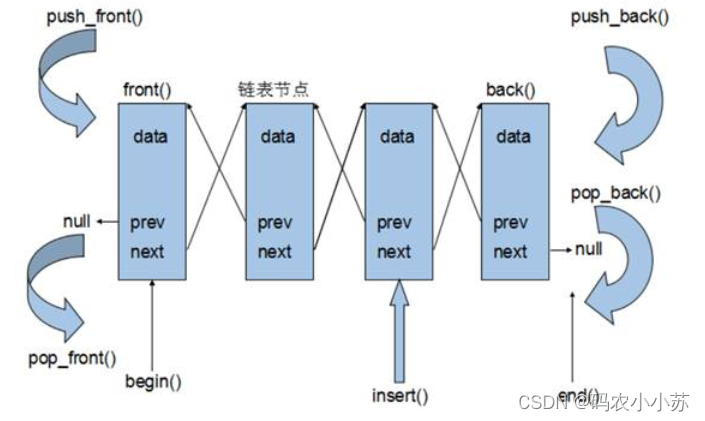
功能
将数据进行链式存储
链表(list)是一种物理存储单元上非连续的存储结构,数据元素的逻辑顺序是通过链表中的指针链接实现的
链表的组成:链表由一系列结点组成
结点的组成:一个是存储数据元素的数据域,另一个是存储下一个结点地址的指针域
STL中的链表是一个双向循环链表

由于链表的存储方式并不是连续的内存空间,因此链表list中的迭代器只支持前移和后移,属于双向迭代器
list的优点:
- 采用动态存储分配,不会造成内存浪费和溢出
- 链表执行插入和删除操作十分方便,修改指针即可,不需要移动大量元素
list的缺点:
- 链表灵活,但是空间(指针域) 和 时间(遍历)额外耗费较大
List有一个重要的性质,插入操作和删除操作都不会造成原有list迭代器的失效,这在vector是不成立的。
总结:STL中List和vector是两个最常被使用的容器,各有优缺点
3.7.2 list构造函数
功能描述:
- 创建list容器
函数原型:
list<T> lst;//list采用采用模板类实现,对象的默认构造形式:list(beg,end);//构造函数将[beg, end)区间中的元素拷贝给本身。list(n,elem);//构造函数将n个elem拷贝给本身。list(const list &lst);//拷贝构造函数。
#include <list>
void printList(const list<int>& L) {
for (list<int>::const_iterator it = L.begin(); it != L.end(); it++) {
cout << *it << " ";
}
cout << endl;
}
void test01()
{
list<int>L1;
L1.push_back(10);
L1.push_back(20);
L1.push_back(30);
L1.push_back(40);
printList(L1);
list<int>L2(L1.begin(),L1.end());
printList(L2);
list<int>L3(L2);
printList(L3);
list<int>L4(10, 1000);
printList(L4);
}
int main() {
test01();
system("pause");
return 0;
}
list 赋值和交换
功能描述:
- 给list容器进行赋值,以及交换list容器
函数原型:
assign(beg, end);//将[beg, end)区间中的数据拷贝赋值给本身。assign(n, elem);//将n个elem拷贝赋值给本身。list& operator=(const list &lst);//重载等号操作符swap(lst);//将lst与本身的元素互换。
#include <list>
void printList(const list<int>& L) {
for (list<int>::const_iterator it = L.begin(); it != L.end(); it++) {
cout << *it << " ";
}
cout << endl;
}
//赋值和交换
void test01()
{
list<int>L1;
L1.push_back(10);
L1.push_back(20);
L1.push_back(30);
L1.push_back(40);
printList(L1);
//赋值
list<int>L2;
L2 = L1;
printList(L2);
list<int>L3;
L3.assign(L2.begin(), L2.end());
printList(L3);
list<int>L4;
L4.assign(10, 100);
printList(L4);
}
//交换
void test02()
{
list<int>L1;
L1.push_back(10);
L1.push_back(20);
L1.push_back(30);
L1.push_back(40);
list<int>L2;
L2.assign(10, 100);
cout << "交换前: " << endl;
printList(L1);
printList(L2);
cout << endl;
L1.swap(L2);
cout << "交换后: " << endl;
printList(L1);
printList(L2);
}
int main() {
//test01();
test02();
system("pause");
return 0;
}
list 大小操作
功能描述:
- 对list容器的大小进行操作
函数原型:
-
size();//返回容器中元素的个数 -
empty();//判断容器是否为空 -
resize(num);//重新指定容器的长度为num,若容器变长,则以默认值填充新位置。 //如果容器变短,则末尾超出容器长度的元素被删除。
-
resize(num, elem);//重新指定容器的长度为num,若容器变长,则以elem值填充新位置。 //如果容器变短,则末尾超出容器长度的元素被删除。
示例:
#include <list>
void printList(const list<int>& L) {
for (list<int>::const_iterator it = L.begin(); it != L.end(); it++) {
cout << *it << " ";
}
cout << endl;
}
//大小操作
void test01()
{
list<int>L1;
L1.push_back(10);
L1.push_back(20);
L1.push_back(30);
L1.push_back(40);
if (L1.empty())
{
cout << "L1为空" << endl;
}
else
{
cout << "L1不为空" << endl;
cout << "L1的大小为: " << L1.size() << endl;
}
//重新指定大小
L1.resize(10);
printList(L1);
L1.resize(2);
printList(L1);
}
int main() {
test01();
system("pause");
return 0;
}
list 插入和删除
功能描述:
- 对list容器进行数据的插入和删除
函数原型:
- push_back(elem);//在容器尾部加入一个元素
- pop_back();//删除容器中最后一个元素
- push_front(elem);//在容器开头插入一个元素
- pop_front();//从容器开头移除第一个元素
- insert(pos,elem);//在pos位置插elem元素的拷贝,返回新数据的位置。
- insert(pos,n,elem);//在pos位置插入n个elem数据,无返回值。
- insert(pos,beg,end);//在pos位置插入[beg,end)区间的数据,无返回值。
- clear();//移除容器的所有数据
- erase(beg,end);//删除[beg,end)区间的数据,返回下一个数据的位置。
- erase(pos);//删除pos位置的数据,返回下一个数据的位置。
- remove(elem);//删除容器中所有与elem值匹配的元素。
示例:
#include <list>
void printList(const list<int>& L) {
for (list<int>::const_iterator it = L.begin(); it != L.end(); it++) {
cout << *it << " ";
}
cout << endl;
}
//插入和删除
void test01()
{
list<int> L;
//尾插
L.push_back(10);
L.push_back(20);
L.push_back(30);
//头插
L.push_front(100);
L.push_front(200);
L.push_front(300);
printList(L);
//尾删
L.pop_back();
printList(L);
//头删
L.pop_front();
printList(L);
//插入
list<int>::iterator it = L.begin();
L.insert(++it, 1000);
printList(L);
//删除
it = L.begin();
L.erase(++it);
printList(L);
//移除
L.push_back(10000);
L.push_back(10000);
L.push_back(10000);
printList(L);
L.remove(10000);
printList(L);
//清空
L.clear();
printList(L);
}
int main() {
test01();
system("pause");
return 0;
}
list 数据存取
功能描述:
- 对list容器中数据进行存取
函数原型:
front();//返回第一个元素。back();//返回最后一个元素。
示例:
#include <list>
//数据存取
void test01()
{
list<int>L1;
L1.push_back(10);
L1.push_back(20);
L1.push_back(30);
L1.push_back(40);
//cout << L1.at(0) << endl;//错误 不支持at访问数据
//cout << L1[0] << endl; //错误 不支持[]方式访问数据
cout << "第一个元素为: " << L1.front() << endl;
cout << "最后一个元素为: " << L1.back() << endl;
//list容器的迭代器是双向迭代器,不支持随机访问
list<int>::iterator it = L1.begin();
//it = it + 1;//错误,不可以跳跃访问,即使是+1
}
int main() {
test01();
system("pause");
return 0;
}
list 反转和排序
功能描述:
- 将容器中的元素反转,以及将容器中的数据进行排序
函数原型:
reverse();//反转链表sort();//链表排序
示例:
void printList(const list<int>& L) {
for (list<int>::const_iterator it = L.begin(); it != L.end(); it++) {
cout << *it << " ";
}
cout << endl;
}
bool myCompare(int val1 , int val2)
{
return val1 > val2;
}
//反转和排序
void test01()
{
list<int> L;
L.push_back(90);
L.push_back(30);
L.push_back(20);
L.push_back(70);
printList(L);
//反转容器的元素
L.reverse();
printList(L);
//排序
L.sort(); //默认的排序规则 从小到大
printList(L);
L.sort(myCompare); //指定规则,从大到小
printList(L);
}
int main() {
test01();
system("pause");
return 0;
}
本篇完!










